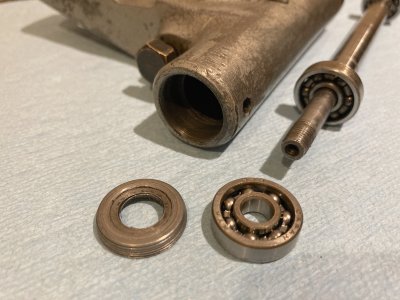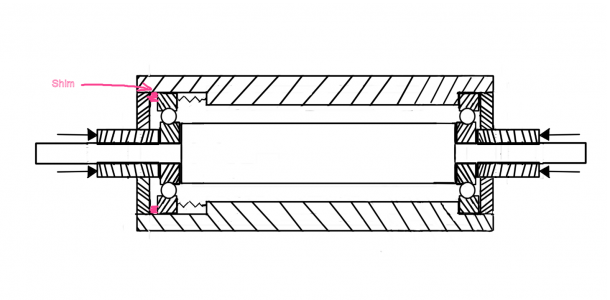- Joined
- Feb 2, 2013
- Messages
- 3,628
The threaded retainer for the bearing largely matches the outer race of the bearing.for your arrangement, with respect, i would suggest these...
use these in opposition, on both ends (or not)
McMaster Carr 94065K32

The spindle that was in the grinder when I got it is bent. I'm sure it is user-made rather than original.
Thanks for looking at this but I think my old Series 14 grinder is rather different from the modern ones--mainly due to lubrication. Mine has a Gits oiler in the center of tube casting as is pictured in the Care & Operation manual [1]. I believe the modern ones must be using sealed, lubricated for life bearings. With the arrangement of parts shown in the modern parts list, I don't think oil could flow effectively through to my open bearings. Sealed bearings are about 0.063" wider than open bearings and there is so little room in the bearing housing that I don't believe sealed bearings would fit. Too few threads on the bearing cap would be able to engage. So I think there must have been a bit of a redesign whenever they switched to sealed bearings. Mine is designed so that lots of oil passes through the bearings regularly to keep them lubricated while flushing away grinding debris.After some poking around that may very well be an original. Is yours just a 2 speed (only 2 pulleys)?
Looks damn near identical to the series 14 which only has 2 speeds & the exploded view can be seen here:
Tool Post Grinder Replacement Parts | Dumore Series 14 Tool Post Grinders
www.dumoretools.com
Picture posted above in the thread appears to be a series 44 with an exploded view here:
Tool Post Grinder Replacement Parts | Dumore Series 44 Tool Post Grinders
www.dumoretools.com
They look pretty different but it appears that preload is dealt with in the same manner using a "double back to back" arrangement. Use of thrust washers is a dead giveaway that the bearing caps are loading the inner races, not outer. Wave springs on one side allow the cap to lock the inner race in position on the shaft but exert force on the outer race through the spring instead. So that's the axially floating side & the other locks both axially & radially.
I hope this helps!
. So I think there must have been a bit of a redesign whenever they switched to sealed bearings. Mine is designed so that lots of oil passes through the bearings regularly to keep them lubricated while flushing away grinding debris.
Unfortunately I can't find a parts diagram that relates to mine.
Re the bearing caps loading the inner races, wouldn't that create massive friction? The bearing caps are not spinning but the inner race is spinning (and up to 16,000 rpm). Thus if the spring pushes between the bearing cap and the inner race, it must be sliding against something, creating friction. That's why I thought the spring washer must be pushing between the outer race and either the bearing housing or the bearing cap. All of those parts are stationary. Am I missing something?
Craig


